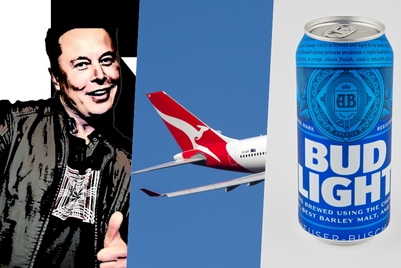
Brand extensions represent a simple way to infuse products with a built-in marketing base. Some are brilliant, others are complete failures (7-Up soda-flavoured marinade anyone?). Occasionally marketers can’t resist the promise of a lucrative licensing deal, even when it might tarnish their coveted name. Likewise, some manufacturers want any recognized label on their product, anticipating huge volume sales. This over-eagerness can lead to some odd marriages. Here’s our picks for 2013’s least expected extensions. Some are a real stretch.
5. Microsoft Bra

Several years ago Evian released its water bra, a product few bought but many loved to poke fun at. Regretfully it’s too old of a development to chide again here, though it does set a head-scratching standard for misguided product extensions. Thankfully, this year Microsoft has come to the rescue with its own ill-advised undergarment product extension.
That’s right, a Microsoft bra. As uncool as Evian’s undergarment proved to be (it was all about lowering body temperature, or rather the temperature of certain body parts), Microsoft went in for the full geek factor with its brassier rendition, making it all about data collection. Or at least that was the perception after a research paper, complete with a bra-gadget schematic, viraled across the internet earlier this month. Researchers, including one from the software giant, devised a set of electrocardiogram and accelerometer sensors that could fit inside a bra to send EKG data to a smartphone.
The goal was to help women monitor their moods (because most people don’t know when they feel stressed?) in order to avoid overeating. But the company claims it has no plan to actually market such a device, which is decisively disappointing for Asia’s vast cache of garment and OEM suppliers who could have collaborated on production.
4. Pumpkin Pudding Halloween Kit Kat

The not-so-scary flavour was new for 2013, and frankly, the effort is tame compared to other Japanese versions of the classic candy bar. Most stray pretty far from the original’s cheap-chocolate and wafer approach. The range of flavours seems to purposely reach beyond the bounds of what makes candy a coveted treat – soy sauce and veggie for example – making the confection a collectable curiosity, with many a blog cataloguing the savory variations. Let’s hope for something more outlandish next year. Tea egg or sushi rice, perhaps?
3. Canada Dry Hot Ginger Ale
Only in Asia do the words “hot” and “soda” fit together. The product released this fall and reportedly took four years to develop, largely because carbonation and heat are more than linguistically opposed: combining them is also a chemical challenge because heating fizzy things usually wrings the bubbles out of them. For that reason the Drinks Business Review nominated the hot soda for an innovation award. Note that the recognition is more for the well-engineered can, not so much for what’s inside it.
2. Grumpy Cat Grumppuccino
International internet sensation Grumpy Cat inked a deal this summer to extend its “brand” to an ultra-hip coffee concoction. Never mind the unpleasant connections that might come to mind when associating cats with liquids, this product is supposed to be about how you feel before having your coffee (though if the bottle bears a grumpy label it is hard to imagine why you’d choose that to perk up). The crabby cat also lent its frown to the Friskies brand cat food earlier in the year, which may be a more sensible co-branding effort but still seems semantically opposed. Guess you have to be a cat person to appreciate it.
1. Hello Kitty beer

Hello Kitty recently had her 40th birthday, so she is of drinking age. But a brand that targets little girls (though just as often has as much if not more success with the over-30 set) has little reason to get into the liquor business. Bearing in mind the association with cats and liquids mentioned at the number two spot, as well as the feline-inspired description of the taste of many a cheap beer, this product takes the top spot for oddest brand extension. There is simply nothing cute about the implications of seeming to peddle alcohol to little kids. Furthermore, fruity beers (like banana) are just gross. A master brewer at a craft beer company commented that the “only time we add fruit is to cover up a batch that went wrong.” Sanrio licensed the beerish product with the Taiwan Tsing Beer Company.




+(900+x+600+px)+(3).png&h=334&w=500&q=100&v=20250320&c=1)
+(900+x+600+px).jpg&h=334&w=500&q=100&v=20250320&c=1)
.jpg&h=334&w=500&q=100&v=20250320&c=1)


.jpg&h=334&w=500&q=100&v=20250320&c=1)
+(900+x+600+px).png&h=334&w=500&q=100&v=20250320&c=1)

+(900+x+600+px)+(1).png&h=334&w=500&q=100&v=20250320&c=1)

.jpg&h=268&w=401&q=100&v=20250320&c=1)


.jpg&h=268&w=401&q=100&v=20250320&c=1)



